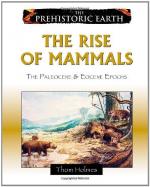|
This section contains 382 words (approx. 2 pages at 300 words per page) |
The Eocene Epoch, second of the five epochs into which the Tertiary Period is divided, lasted from 54 to 38 million years ago. Mammals became the dominant land animals during this epoch.
The Eocene Epoch (meaning dawn of the recent period, from the Greek eos, dawn, and koinos, recent), like the other epochs of the Tertiary Period, was originally defined in 1833 by the English geologist Charles Lyell (1797–1875) on the basis of how many modern species are found among its fossils. The Eocene Epoch was defined by Lyell as that time where 1–5% of the species were modern (i.e., are still alive today). The Eocene Epoch's boundaries are therefore arbitrary, not set by mass extinctions or other clear-cut events.
For most of the Eocene Epoch, the global climate was warm and rainy. Ice caps were small or nonexistent. Early Eocene Epoch sea levels were low, creating land bridges between Asia and North America via the Bering Strait, North America and Europe via Greenland, and Australia and Antarctica. Late in the epoch Antarctica drifted south, opening a deep-water channel between it and Australia that caused a global cooling trend by allowing the formation of the circum-Antarctic current.
The Eocene Epoch saw the replacement of older mammalian orders by modern ones. Hoofed animals first appeared, including the famous Eohippus (dawn horse) and ancestral rhinoceroses and tapirs. Early bats, rabbits, beavers, rats, mice, carnivorous mammals, and whales also evolved during the Eocene Epoch. The earliest Eocene Epoch mammals were all small, but larger species, including the elephant-sized titanothere, evolved toward the end of the epoch.
Many flowering plants evolved in the Eocene Epoch. Especially important are the grasses, which had first appeared in the late Cretaceous Period but did not become diverse and ubiquitous until the Eocene Epoch. Abundant grass encouraged the evolution of early grazing animals, including Eohippus. Familiar tree species such as birch, cedar, chestnut, elm, and beech flourished during the Eocene Epoch; aquatic and insect life were much the same as today.
See Also
Archean; Cambrian Period; Carbon Dating; Cenozoic Era; Dating Methods; Devonian Period; Fossil Record; Geologic Time; Historical Geology; Holocene Epoch; Jurassic Period; Mesozoic Era; Miocene Epoch; Mississippian Period; Oligocene Epoch; Ordovician Period; Paleozoic Era; Pennsylvanian Period; Phanerozoic Eon; Pleistocene Epoch; Pliocene Epoch; Precambrian; Proterozoic Era; Quaternary Period; Silurian Period
|
This section contains 382 words (approx. 2 pages at 300 words per page) |


